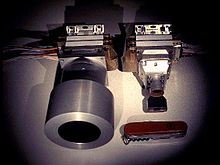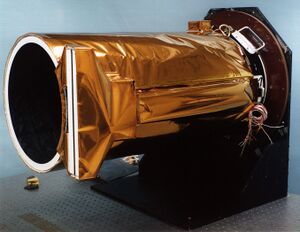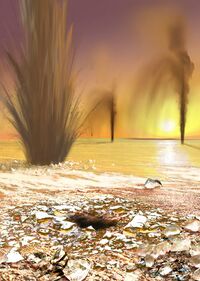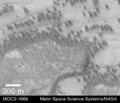أنظمة مالين لعلوم الفضاء
 | |
| النوع | Privately held company |
|---|---|
| تأسست | 1990 |
| المقر الرئيسي | San Diego, California |
الأشخاص الرئيسيون | Michael C. Malin, CEO |
| الموقع الإلكتروني | www |
أنظمة مالين لعلوم الفضاء(أو MSSS) هي شركة مقرها سان دييغو في ولاية كاليفورنيا، تطورالتصاميم ، وتصنع المعدات المخصصة للسفر على متن المركبات الفضائية غير المأهولة. ويرأس مؤسسة MSSS كبير العلماء والمدير التنفيذي مايكل .ك. مالين .
تأسست في عام 1990، وكانت مهمتهم الأولى وقد فشلت عام 1993 أوبزيرفر المريخ التي من أجلها تم تطوير وتشغيل الكاميرا Camera Ground Data System . بعد هذه البعثة تم اختيارهم لتزويد الكاميرا الرئيسية للMars Global Surveyor. الماسح المريخى الجلوبال .
صممت أيضا الكاميرات التى حملت على المريخ لاندر القطبى 2001 المريخ أوديسي المريخ الاستطلاع المتتبع2001 المريخ أوديسي , العنقاء و فينيكس لاندر.


Liquid water on Mars
In June 2000, evidence for water currently under the surface of Mars was discovered in the form of flood-like gullies.[1] The question that was immediately asked was: is this an ongoing process or is this ancient and simply well preserved evidence of water/liquid flow? Most scientists agree that it is highly likely that water did flow on Mars in the distant past.[2]
Malin's camera controllers attempted to answer this question by taking photos of the same locations and in 2005 observation showed two areas where change had clearly occurred within the time of the photos (in other words, the activity was happening in present time and was not ancient).
On December 6, 2006, MSSS announced that it had discovered evidence that liquid water had likely flowed on Mars within the past five years. At a press conference, NASA showed images taken by the Mars Global Surveyor that suggested that water occasionally flows on the surface of Mars. The images did not actually show flowing water. Rather, they showed changes in craters and sediment deposits, providing the strongest evidence yet that water coursed through them as recently as several years ago, and is perhaps doing so even now. The findings were published in the December 8, 2006 issue of the journal Science.[3]
Malin Systems published several documents which describe what they found:
- New Gully Deposit in a Crater in Terra Sirenum: Evidence That Water Flowed on Mars in This Decade?
- Support for Hypothesis that Groundwater is Source for Fluid Responsible for Erosion in Martian Gullies
- Why the New Gully Deposits Are Not Dry Dust Slope Streaks
Before the December 2006 paper, some researchers were skeptical that liquid water was responsible for the surface features seen by the spacecraft. They said other materials such as sand or dust can flow like a liquid and produce similar results. At this stage, (late 2006) the flowing water hypothesis looks strong, however more evidence is needed. For more, see Life on Mars.
الفوارات في المريخ

The MSSS cameras on board the Mars Global Surveyor, produced high resolution images that were also processed by Malin Space Science Systems, and discovered the intriguing polar features informally known as 'dark dune spots' and 'spiders'.[4] The origin of dark dune spots and the dark slope streaks emanating from them is yet uncertain, and various hypotheses have been put forward on their origin and formation process. The current model proposed by NASA and European teams propose cold geyser-like systems that eject CO2 and dark basaltic sand. The seasonal frosting of some areas near the southern ice cap results in the formation of transparent 1 metre thick slabs of dry ice above the ground. With the arrival of spring, sunlight warms the subsurface and pressure from subliming CO2 builds up under a slab, elevating and ultimately rupturing it. This leads to geyser-like eruptions of CO2 gas mixed with dark basaltic sand or dust.[5][6][7][8] This process is rapid, observed happening in the space of a few days, weeks or months, a growth rate rather unusual in geology – especially for Mars. The gas rushing underneath a slab to the site of a geyser carves a spider-like pattern of radial channels under the ice.
Dark dune spots on Mars, taken by the Mars Global Surveyor on August 10, 1999.
Dark dune spots on Mars, taken by the Mars Global Surveyor on August 10, 1999.
قائمة المنتجات
Malin manufactured the following cameras for NASA spacecrafts:
الهامش
- ^ Malin, Michael C., Edgett, Kenneth S., "Evidence for Recent Groundwater Seepage and Surface Runoff on Mars". Science (2000) Vol. 288. no. 5475, pp. 2330–2335.
- ^ MSSS June 2000 article
- ^ Scientists: Water likely flows on Mars, Associated Press, accessed on December 7, 2006
- ^ Albee, A. L.; F. D. Palluconi; R. E. Arvidson (March 1998). "Mars Global Surveyor Mission: Overview and Status". Science. 279 (5357): 1671–1672. Bibcode:1998Sci...279.1671A. doi:10.1126/science.279.5357.1671. PMID 9497277.
- ^ "NASA Findings Suggest Jets Bursting From Martian Ice Cap". Jet Propulsion Laboratory. NASA. August 16, 2006. Retrieved August 11, 2009.
- ^ Kieffer, H. H. (2000). "Annual Punctuated CO2 Slab-Ice and Jets on Mars" (PDF). Mars Polar Science 2000 (1057): 93. Bibcode:2000mpse.conf...93K.
- ^ Portyankina, G., ed. (2006). "Simulations of Geyser-Type Eruptions in Cryptic Region of Martian South" (PDF). Fourth Mars Polar Science Conference.
- ^ Kieffer, Hugh H.; Philip R. Christensen and Timothy N. Titus; Titus, Timothy N. (May 30, 2006). "CO2 jets formed by sublimation beneath translucent slab ice in Mars' seasonal south polar ice cap". Nature. 442 (7104): 793–796. Bibcode:2006Natur.442..793K. doi:10.1038/nature04945. PMID 16915284. S2CID 4418194.



